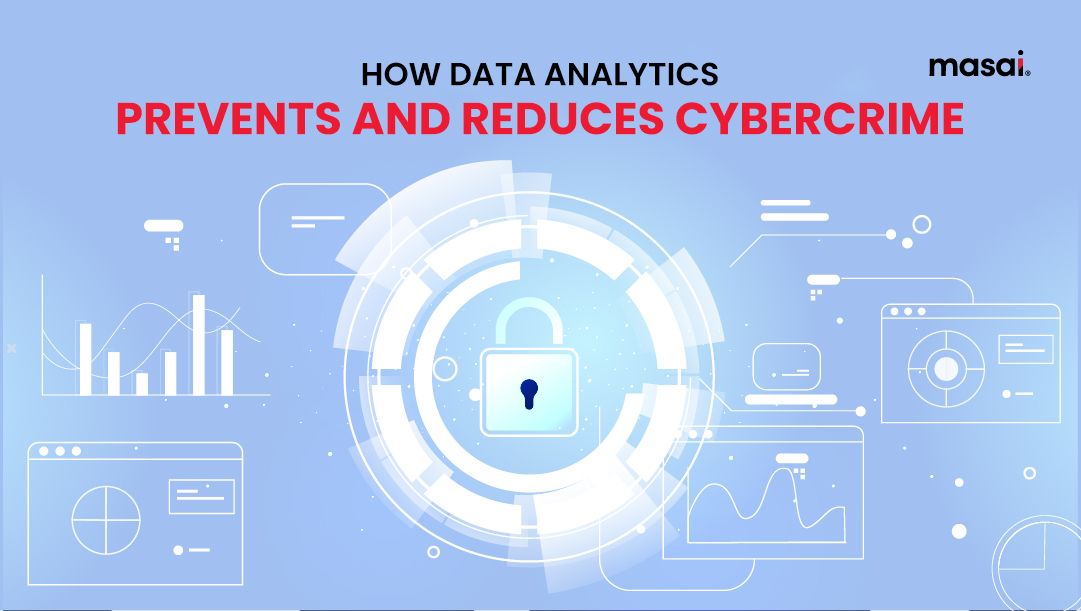Harnessing Data Analytics to Prevent and Combat Cybercrime
Data analytics is the scientific analysis of data that happens at the back end. It not just gathers data but also deploys various methods that provide deep insights that help predict and reduce cybercrime incidents.

Discover how data analytics empowers businesses to predict and thwart cybercrime. Learn about its impact on financial technology and cybersecurity.
Prevention is better than cure. This is true in the financial sphere where CIBIL score helps prevent fraud.
CIBIL score is determined by tracking a person’s history, net assets, net worth, and liabilities. It also takes into account punctuality in terms of repayment of debts/bills. After taking into account all of these factors, a 3-digit score is generated which is the CIBIL score.
Across demographics, there are different measures that are taken into account to assess a person’s financial health. The CIBIL score, ranging from 300 to 900, is a crucial indicator of an individual's creditworthiness. Lenders use this score to evaluate the risk associated with extending credit to a borrower.
A higher score typically implies a lower credit risk, making securing loans and credit cards easier. However, maintaining a favourable CIBIL score requires responsible financial management and consistent repayment of debts and bills.
CIBIL has time and again proved to be the instrument that helps financial institutions identify and prevent fraud.
Data analytics is the scientific analysis of data that happens at the back end. It not just gathers data but also deploys various methods that provide deep insights that help predict and reduce cybercrime incidents.
This article would clarify just that but before that happens, let us look into the various challenges that gave rise to data analytics.
The challenges in combating cybercrime before data analytics
Before big data analytics boomed, there were two big challenges that posed threat to online user activities.
-Volume
-Variety
Volume:
The digital revolution made it possible to amass a mountain of data.
It would be considered foolish to even imagine a human going through such a large amount of data and fishing out suspicious activities. This was a big problem and thus the need for something that could potentially solve this problem was felt. Data analytics proved to be the solution.
With the help of data analytics, UPI is able to push 20.5 million dollars worth of transactions every year, track every one of them, and raise red flags whenever there is a smell of foul play.
Share markets can serve as another great example where data analytics plays a major role in managing and securing data.
Right from the moment, the sounds of the opening bells are heard till the moment the market closes, millions of trades take place and one should not forget that this doesn’t take into account just the Indian share market but the international ones as well.
The sheer amount of trades that happen with just a single button click is unimaginable and data analytics safeguards all of them without breaking a sweat.
Variety:
One interesting thing about cybercrime is the variety. Hackers and fraudsters evolve very fast and this is what keeps them in the game. They are very good at finding loopholes and vulnerabilities.
The presence of hundreds of banks in India brings in use a wide range of software technology apart from various financial products such as credit cards, insurances, bonds, shares, loans, mutual funds, etc. The data thus accumulated here makes systems susceptible to vulnerabilities that can be taken advantage of and lead to a compromise of sensitive data.
With human intervention, the ability to detect even one of these evolving methods of attacks might have been remotely possible but getting hold of all of them was unrealistic.
When we mix up the complexities that volume and variety of data bring to the table, the need for data analytics is felt. This is where data and computing come together to solve problems with the help of big data analytics.
The scale and diversity of data generated in today's digital landscape make manual detection of evolving cybercrime methods nearly impossible. Therefore, relying on data analytics becomes paramount.
Data analytics, powered by big data techniques and computing capabilities, provides the essential means to address these complex challenges effectively. It enables organisations to proactively identify and respond to emerging threats, ultimately bolstering cybersecurity measures.
Bringing the best of both worlds: CIBIL Score
Millions of people apply for personal as well as professional loans every day. A major factor that comes into effect while applying for loans is the CIBIL score.
A CIBIL score is assigned to every person who is a PAN card holder and has or has not had a prior history of borrowing loans from banking institutions.
A loan gets issued at a comparatively lower rate of interest only when an individual or an organisation only when meets pre-defined criteria set forth in terms of CIBIL score. In case a pre-defined CIBIL score is not met, it might result in the non-issuance of loans or their issuance at a higher rate of interest.
A huge number of people applying for loans brings in volume while the other pre-requisite information required such as account repayment history, credit utilisation, previous loans availed, and credit mix when taken into account brings in variety.
Data collection is one thing and making sense of it by using a structure is another and this is where data analytics jumps in and plays a crucial role in determining the CIBIL score for people and help makes decisions regarding the issuance and non-issuance of loans as well safeguarding the enormous amounts of sensitive data thus gathered.
How is Data Analytics used to turn massive amounts of data into actionable insights?
Big data analytics make it easier for institutions to swiftly run through an enormous amount of data from various sources, form patterns, discover anomalous behaviours, reduce them and further improve the overall resistance of cybersecurity systems.
The patterns gathered through big data don’t just help organisations figure out vulnerabilities but also get valuable insights into their business and use them further to make changes in the way they do business.
By putting various tools such as statistics, machine learning algorithms, and computer systems to good use big data analytics provides structure to a large amount of data and utilises the same to gather knowledge on possible threats to data.
The tools mentioned above come in handy in gathering a large volume of unstructured data from different sources, filtering out relevant historical data, and further analysing them to establish ideal reference models.
The reference model thus created proves useful in highlighting anomalous behaviours and predicting cyber attacks.
Moreover, fraud analytics enables businesses to stay proactive in identifying potential security risks by continuously monitoring and updating these reference models based on evolving cyber threats. This ongoing refinement of predictive models ensures that fraud detection remains effective and adaptable in the face of constantly changing criminal tactics.
How data analytics has changed the landscape of financial technology?
The rise of financial technology companies means a large amount of data gets accumulated every second and thus tracking and tackling fraudulent activities has become the need of the hour.
This is where big data analytics is making its presence felt. By deploying data analytics, financial institutions are able to identify fraudulent patterns, detect anomalous behaviors and use the insights gained to further bring down the risk to a minimum.
Credit processing giants such Visa, MasterCard, AMEX, Chase Bank, etc pounced upon the big data opportunity to give out loans in a manner that ensured their safety. They were able to use their historical data to uncover insightful trends and patterns. These patterns helped them flag down suspicious activities, and identify fraudulent activities in real-time thus enabling them to gain more control over their data which later proved helpful in strengthening the way they did business.
The utilisation of big data by credit processing giants like Visa, MasterCard, AMEX, and Chase Bank exemplifies the power of data-driven strategies in risk management. By leveraging historical data, these institutions identified trends and proactively detected suspicious behaviour and real-time fraud.
This approach enhanced their data management and fortified their overall business operations. This data-driven insight bolstered their security measures and risk mitigation strategies.
Conclusion
Cybersecurity is just a small subset of the various domains data analytics can step in to make life easier for people. And it indeed is changing the landscape of business operations across industries.
It has been more than a decade since big data made its presence felt and its application has only seen an upward trend since then. Organisations today depend on big data to respond to their customers’ evolving needs, their expectations, keep risks well beyond the shores, curate amazing customer experiences, etc.
All of this brings us to just one conclusion: “The future of big data analytics is bright”. And thus this is the time to cash on the opportunity.
FAQs
How does data analytics prevent and reduce cybercrime?
Data analytics involves scientific data analysis to gain deep insights that help predict and mitigate cybercrime incidents. Data analytics plays a crucial role in safeguarding against cyber threats by processing large volumes of data and identifying anomalous behaviours.
How does the CIBIL score relate to data analytics and fraud prevention?
CIBIL score is determined by analysing an individual's financial history, net assets, liabilities, and punctuality in debt repayment. Data analytics is used to assess and determine these scores, aiding financial institutions in identifying and preventing fraud by making informed decisions about loan issuance and safeguarding sensitive financial data.

